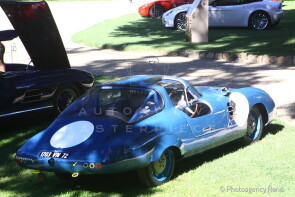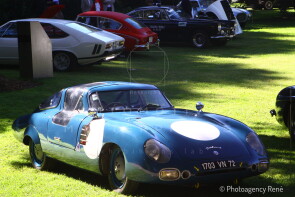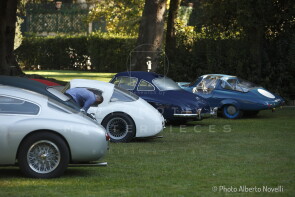
1956 Panhard Monopole X86
ON/OFF
Why am I an Automotive Masterpiece?
The Panhard Dyna X was a subcompact car produced by the French manufacturer Panhard from 1948 to 1953. It holds the distinction of being the first mass-produced car with an all-aluminum body. In 1943, engineer Jean-Albert Grégoire presented a car that incorporated many of the technical principles of the Amilcar Compound (notably its chassis and suspension). The project was initiated by Aluminium Français to promote the use of aluminum in automotive construction, but initially failed to attract the interest of manufacturers. However, under the framework of the “Plan Pons,” Panhard reached an agreement with Grégoire to continue development of the AFG prototype (Aluminium Français – Grégoire), providing the mechanical components. The result was the Dyna, featuring an aluminum body on a steel frame, an air-cooled 610 cc aluminum flat-twin engine, a four-speed gearbox, independent suspension on all four wheels (coil springs in front and torsion bars at the rear), and—most notably—front-wheel drive. The Dyna was first shown at the 1946 Paris Motor Show, and production began in October 1947, with bodywork subcontracted to Facel-Métallon (later known for producing the luxurious Facel Vega). From 1948, the car was sold as the Dyna X type 100 (X84), with only minimal changes from the 1946 prototype. The name referenced its top speed of 100 km/h. In 1950, the model gained a new grille with a central circular motif, and the type 110 (X85) replaced the 100. The 610 cc engine (classified as 3 CV) was upgraded from 22 to 28 hp (SAE). In April 1950, a new 745 cc engine (4 CV) producing 32–34 hp was introduced in the type 120 (X86). In February 1952, an optional Sprint version of the 4 CV engine offered 36–37 hp, thanks to a revised camshaft and a twin-barrel carburetor. In April, a roadster derivative named Dyna X Junior was launched. In June, the type 130 (X87) received a more powerful 5 CV / 851 cc engine, while the older types 110 and 120 were discontinued in December. For the 1953 model year, the type 130 could reach a top speed of 130 km/h when fitted with the Sprint 5 CV / 40 hp engine. The Dyna X was a surprisingly spacious vehicle for its class: at 3.82 meters long, it approached the dimensions of higher-segment cars, though its modest engine placed it in direct competition with models like the Renault 4CV, one of its main rivals. The Dyna X was available as a saloon, convertible, and station wagon, with a van version (Dyna K) also produced. Its design was decidedly unconventional, with a rounded body and protruding front headlights. Although the public was initially skeptical due to its unusual styling, the car eventually gained popularity for its agile handling and fuel economy. Performance was also commendable for the time. Built on a tubular chassis, the Dyna X’s aluminum alloy body kept its weight low, enhancing road performance. The model inspired many sporting interpretations, with coachbuilders creating aerodynamic sports cars, both open and closed. The Dyna X was discontinued in 1953 and replaced by the Panhard Dyna Z.
Établissements Monopole was a French manufacturing company that produced parts for automobile engines. The company also built and raced a series of small displacement endurance racing cars. After a series of mergers and acquisitions the Monopole name was retired in Europe, but survives in Africa in the name of a former licensee. In 1950 Panhard increased their involvement in racing, but indirectly, by offering parts and technical support to different racing teams. Monopole availed themselves of this to design a new racing car that used Panhard's air-cooled flat twin engine designed by Louis Delagarde. The car also used the front-wheel drive chassis of the Panhard Dyna X, suitably modified. The car was designed by Monopole's Pierre Bourdereau, who produced a very compact barquette, although due to its full-width ponton-style bodywork the car is often referred to as a tank, as are some other Monopoles. The naming convention for Monopole's Panhard-based racing cars followed that used for the various Dyna X models. In 1953 Panhard decided to become directly involved in racing. Paul Panhard established a racing team under director Etienne de Valance. In 1956, following the accident at Le Mans in 1955, Panhard withdrew from direct racing involvement. Écurie Monopole became Panhard's officially supported racing team. When Monopole upgraded to the X86 series from the Dyna 120, engine displacement grew to 745 cc and was available in two levels of tune from the factory; the GM750 SS3 engine which developed 32.6 hp at 5000, or the GM750 Sprint engine which developed 33.5 hp at 5000 rpm. Monopole X86 cars appeared at Le Mans in 1955, then again in 1957 and 1958. Both barquette and berlinette versions of the X86 were built.
1956 Panhard Monopole X86 with chassis no. 857976 is a result of its times and situation. Since 1926 the Le Mans 24 Hours is characterized by the “Index of performance” classification, connected with the engine capacity, consumption of gasoline and distance. In the post-war years this classification became a private field for the French manufacturers of small capacity cars with advanced aerodynamic specification, like this Monopole: fitted with a 750cc Panhard engine, it raced three times at Le Mans between 1956 and 1958. Its race career continued in the years, after being modified by Monopole with a 850cc engine.




